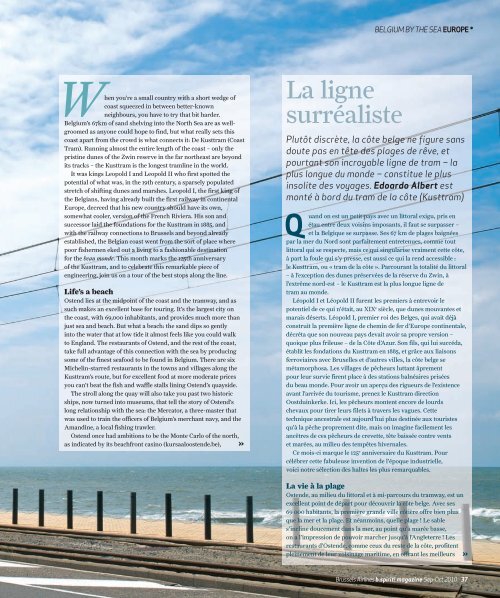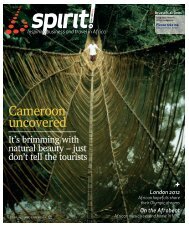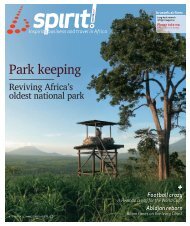september-2010
september-2010
september-2010
Create successful ePaper yourself
Turn your PDF publications into a flip-book with our unique Google optimized e-Paper software.
When you’re a small country with a short wedge of<br />
coast squeezed in between better-known<br />
neighbours, you have to try that bit harder.<br />
Belgium’s 67km of sand shelving into the North Sea are as wellgroomed<br />
as anyone could hope to find, but what really sets this<br />
coast apart from the crowd is what connects it: De Kusttram (Coast<br />
Tram). Running almost the entire length of the coast – only the<br />
pristine dunes of the Zwin reserve in the far northeast are beyond<br />
its tracks – the Kusttram is the longest tramline in the world.<br />
It was kings Leopold I and Leopold II who first spotted the<br />
potential of what was, in the 19th century, a sparsely populated<br />
stretch of shifting dunes and marshes. Leopold I, the first king of<br />
the Belgians, having already built the first railway in continental<br />
Europe, decreed that his new country should have its own,<br />
somewhat cooler, version of the French Riviera. His son and<br />
successor laid the foundations for the Kusttram in 1885, and<br />
with the railway connections to Brussels and beyond already<br />
established, the Belgian coast went from the sort of place where<br />
poor fishermen eked out a living to a fashionable destination<br />
for the beau monde. This month marks the 125th anniversary<br />
of the Kusttram, and to celebrate this remarkable piece of<br />
engineering, join us on a tour of the best stops along the line.<br />
Life’s a beach<br />
Ostend lies at the midpoint of the coast and the tramway, and as<br />
such makes an excellent base for touring. It’s the largest city on<br />
the coast, with 69,000 inhabitants, and provides much more than<br />
just sea and beach. But what a beach: the sand dips so gently<br />
into the water that at low tide it almost feels like you could walk<br />
to England. The restaurants of Ostend, and the rest of the coast,<br />
take full advantage of this connection with the sea by producing<br />
some of the finest seafood to be found in Belgium. There are six<br />
Michelin-starred restaurants in the towns and villages along the<br />
Kusttram’s route, but for excellent food at more moderate prices<br />
you can’t beat the fish and waffle stalls lining Ostend’s quayside.<br />
The stroll along the quay will also take you past two historic<br />
ships, now turned into museums, that tell the story of Ostend’s<br />
long relationship with the sea: the Mercator, a three-master that<br />
was used to train the officers of Belgium’s merchant navy, and the<br />
Amandine, a local fishing trawler.<br />
Ostend once had ambitions to be the Monte Carlo of the north,<br />
as indicated by its beachfront casino (kursaaloostende.be),<br />
La ligne<br />
surréaliste<br />
BELGIUM BY THE SEA EUROPE *<br />
Plutôt discrète, la côte belge ne figure sans<br />
doute pas en tête des plages de rêve, et<br />
pourtant son incroyable ligne de tram – la<br />
plus longue du monde – constitue le plus<br />
insolite des voyages. Edoardo Albert est<br />
monté à bord du tram de la côte (Kusttram)<br />
uand on est un petit pays avec un littoral exigu, pris en<br />
étau entre deux voisins imposants, il faut se surpasser –<br />
et la Belgique se surpasse. Ses 67 km de plages baignées<br />
par la mer du Nord sont parfaitement entretenues, comme tout<br />
littoral qui se respecte, mais ce qui singularise vraiment cette côte,<br />
à part la foule qui s’y presse, est aussi ce qui la rend accessible :<br />
le Kusttram, ou « tram de la côte ». Parcourant la totalité du littoral<br />
– à l’exception des dunes préservées de la réserve du Zwin, à<br />
l’extrême nord-est – le Kusttram est la plus longue ligne de<br />
tram au monde.<br />
Léopold I et Léopold II furent les premiers à entrevoir le<br />
potentiel de ce qui n’était, au XIXe siècle, que dunes mouvantes et<br />
marais déserts. Léopold I, premier roi des Belges, qui avait déjà<br />
construit la première ligne de chemin de fer d’Europe continentale,<br />
décréta que son nouveau pays devait avoir sa propre version –<br />
quoique plus frileuse – de la Côte d’Azur. Son fils, qui lui succéda,<br />
établit les fondations du Kusttram en 1885, et grâce aux liaisons<br />
ferroviaires avec Bruxelles et d’autres villes, la côte belge se<br />
métamorphosa. Les villages de pêcheurs luttant âprement<br />
pour leur survie firent place à des stations balnéaires prisées<br />
du beau monde. Pour avoir un aperçu des rigueurs de l’existence<br />
avant l’arrivée du tourisme, prenez le Kusttram direction<br />
Oostduinkerke. Ici, les pêcheurs montent encore de lourds<br />
chevaux pour tirer leurs filets à travers les vagues. Cette<br />
technique ancestrale est aujourd’hui plus destinée aux touristes<br />
qu’à la pêche proprement dite, mais on imagine facilement les<br />
ancêtres de ces pêcheurs de crevette, tête baissée contre vents<br />
et marées, au milieu des tempêtes hivernales.<br />
Ce mois-ci marque le 125e Q<br />
anniversaire du Kusttram. Pour<br />
célébrer cette fabuleuse invention de l’époque industrielle,<br />
voici notre sélection des haltes les plus remarquables.<br />
La vie à la plage<br />
Ostende, au milieu du littoral et à mi-parcours du tramway, est un<br />
excellent point de départ pour découvrir la côte belge. Avec ses<br />
69 000 habitants, la première grande ville côtière offre bien plus<br />
que la mer et la plage. Et néanmoins, quelle plage ! Le sable<br />
s’incline doucement dans la mer, au point qu’à marée basse,<br />
on a l’impression de pouvoir marcher jusqu’à l’Angleterre ! Les<br />
restaurants d’Ostende, comme ceux du reste de la côte, profitent<br />
pleinement de leur voisinage maritime, en offrant les meilleurs<br />
Brussels Airlines b.spirit! magazine Sep-Oct <strong>2010</strong> 37











